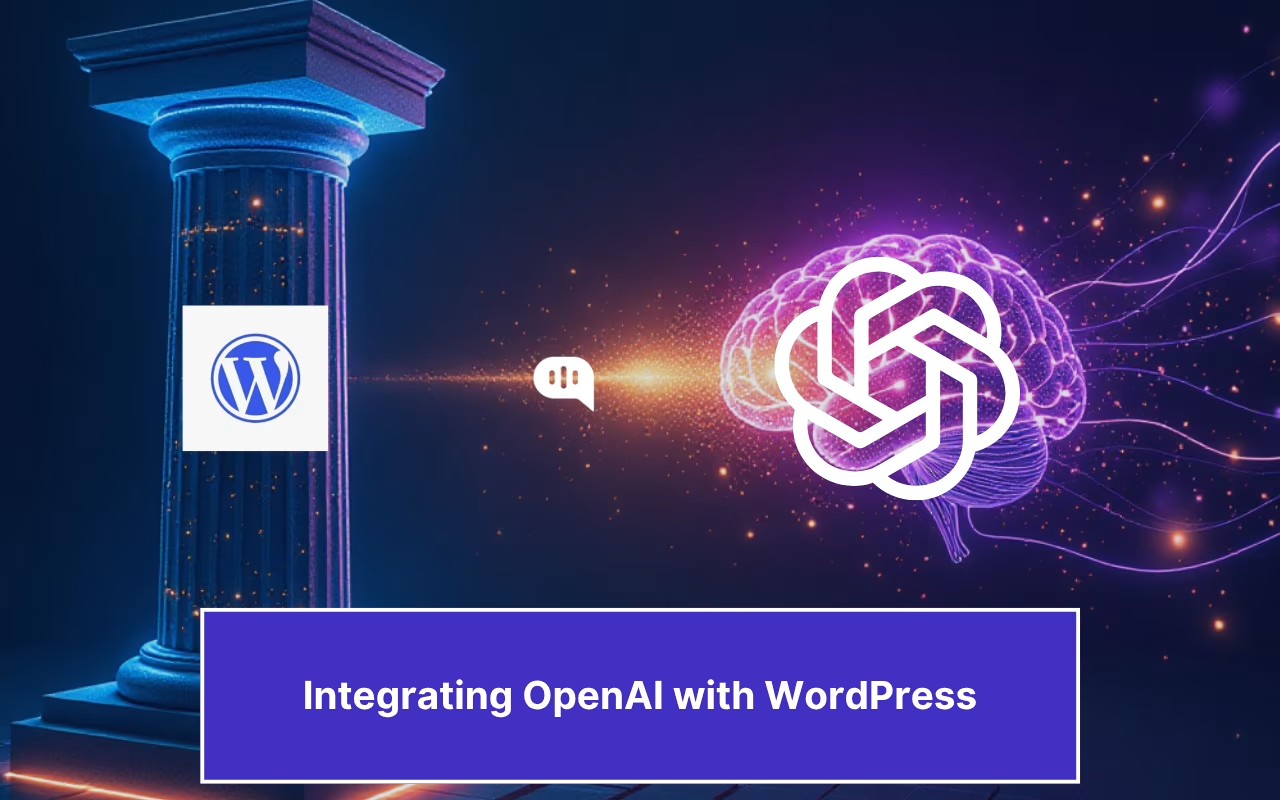Updated on February 20, 2025
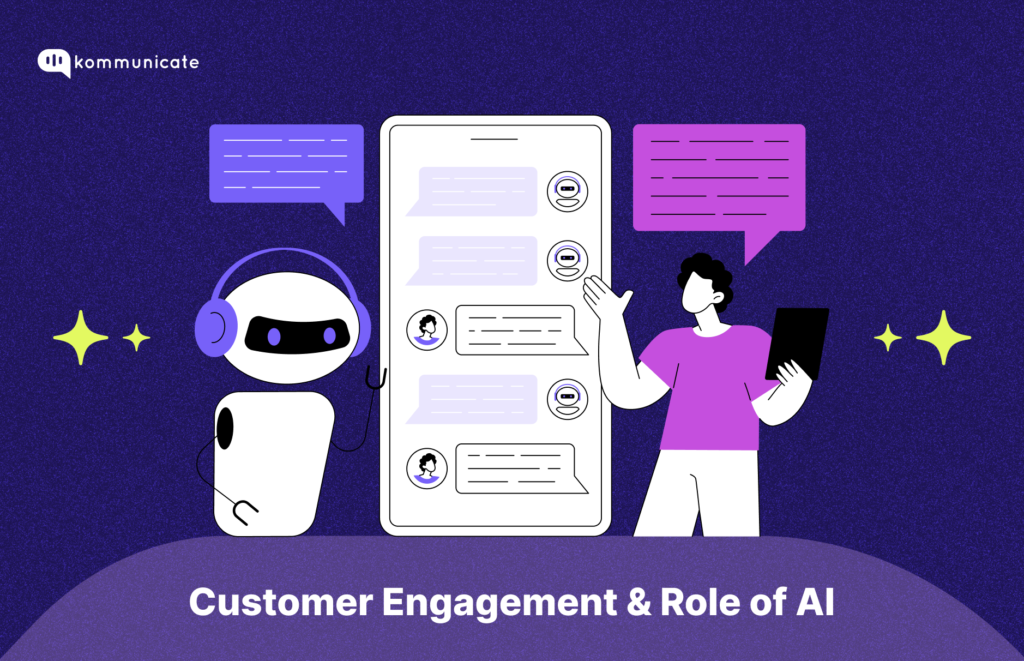
The definition of customer engagement strategy has evolved drastically over the years. Traditionally, it was often seen as a one-way communication channel where businesses would push messages and advertisements to their audience. However, in today’s digital age, AI-driven customer engagement has transformed into a dynamic, two-way interaction between businesses and customers, ensuring personalized experiences that boost satisfaction and loyalty.
Consumers today are no longer just passive recipients. They seek meaningful interactions, expect their voices to be heard, and desire personalized experiences that cater to their individual preferences and needs.
According to McKinsey, 71 percent of consumers expect companies to deliver AI-powered personalized interactions. And 76 percent get frustrated when this doesn’t happen. Another report published in Business Wire shows how customer acquisition costs have increased by as much as 60% in the last five years, making it essential for businesses to invest in AI-powered customer service automation to enhance engagement and reduce churn.
This implies that a business that doesn’t rise up or exceed the consumer demand for increased personalization will lose customers. Add in the growing competition and rising acquisition cost that makes acquiring new customers increasingly challenging, and you can see how customer engagement becomes crucial for growth.
However, many businesses still do not fully understand the realm of customer engagement automation and how to drive it effectively to achieve sustainable growth. With the rise of AI-powered customer engagement tools, companies can leverage technology to enhance customer experience automation and build long-term relationships. And this is what we are going to cover in this article.
- What is Customer Engagement?
- How to Measure Customer Engagement?
- Formulating a Customer Engagement Strategy
- Personalization – The Key to Win
- The Role of AI in Customer Engagement
- Practical Tips for Effective Engagement
- The Future of Customer Engagement
What is Customer Engagement?
While there are multiple definitions of customer engagement available on the internet, it all boils down to developing a deep and meaningful relationship between a business and its customers which goes beyond transactional interactions and focuses on mutual value creation.
The engagement process begins right from the first time the customer encounters a product or brand, and continues through every interaction and touchpoint thereafter at every stage of the purchase cycle – from awareness and consideration to purchase, post-purchase support, and beyond. With each interaction, the goal is to deepen the relationship with the customer and potentially achieve 3 main goals:
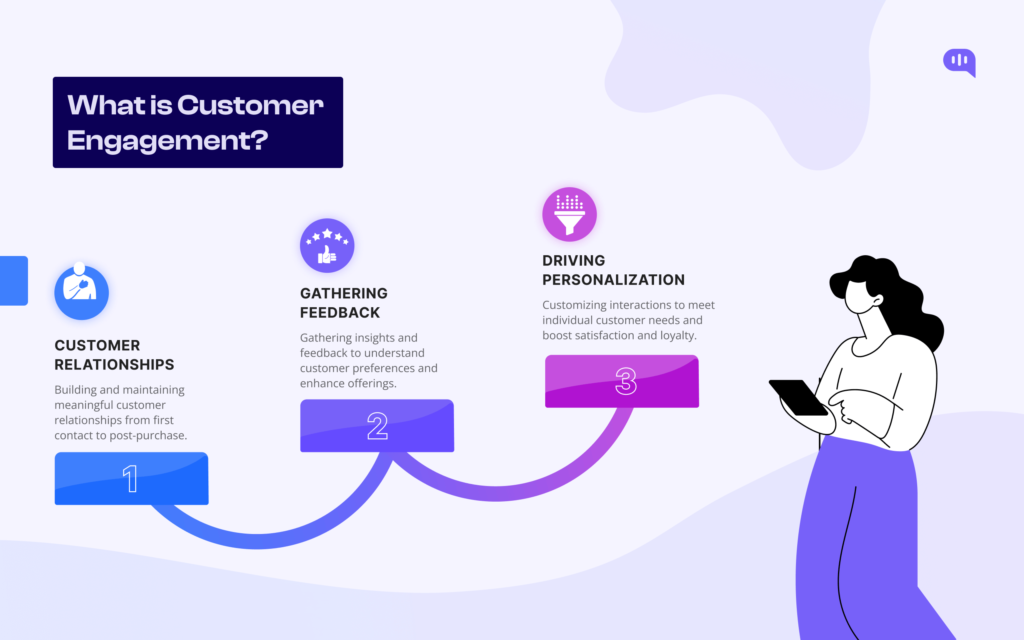
- Building Strong Relationship With Customers: Establishing and nurturing meaningful connections with customers from their initial interaction to post-purchase engagement.
- Gathering Feedback: Continuously collecting insights and feedback to understand customer preferences and improve product or service offerings.
- Driving Personalization: Tailoring interactions and experiences based on individual customer needs and behaviors to enhance satisfaction and loyalty.
Now that we have understood what customer engagement means, the next step is to measure customer engagement. So, let’s see the key metrics that are used to measure customer engagement.
How to Measure Customer Engagement?
Data plays a very important role in understanding if your customers are really finding value in your service or solution. In today’s digital age, there are multiple touch points and tons of data generated at every customer interaction with the product, providing valuable insights into customer preferences, behavior patterns, and satisfaction levels.
Here are some of the key metrics to gauge if your customers are really feeling engaged with your product:
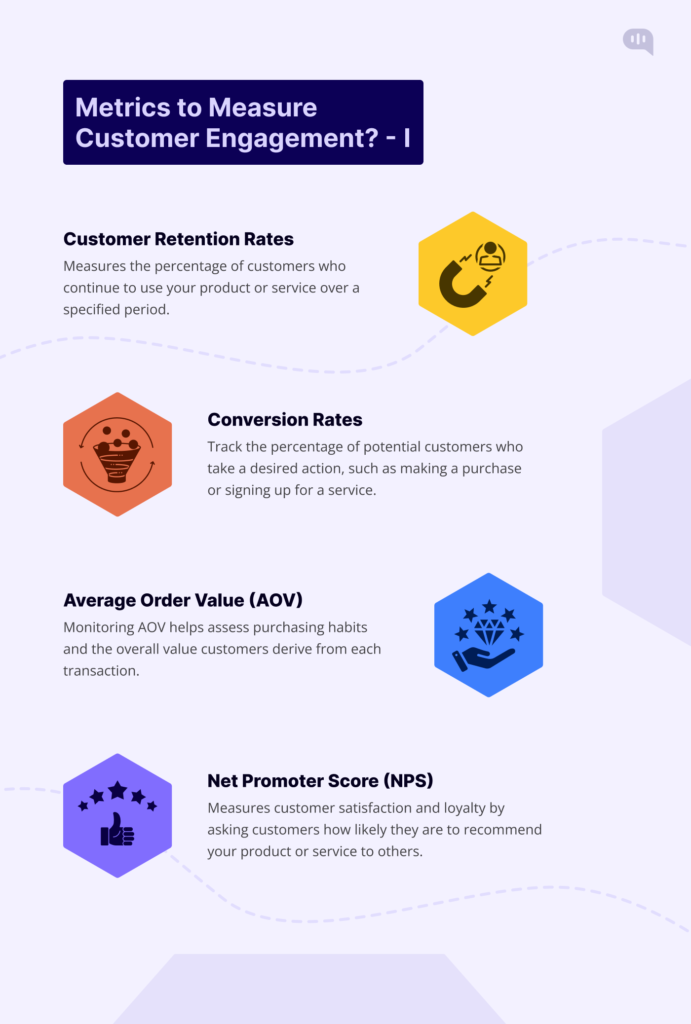
Customer Retention Rates
This metric measures the percentage of customers who continue to use your product or service over a specified period. A high retention rate indicates that customers find value in your offering.
Conversion Rates
Conversion rates track the percentage of potential customers who take a desired action, such as making a purchase or signing up for a service. It reflects how effective your product is at turning prospects into paying customers.
Average Order Value (AOV)
AOV calculates the average amount spent by customers in a single transaction. Monitoring AOV helps assess purchasing habits and the overall value customers derive from each transaction.
Net Promoter Score (NPS)
NPS measures customer satisfaction and loyalty by asking customers how likely they are to recommend your product or service to others. It categorizes respondents as promoters, passives, or detractors to gauge overall sentiment.
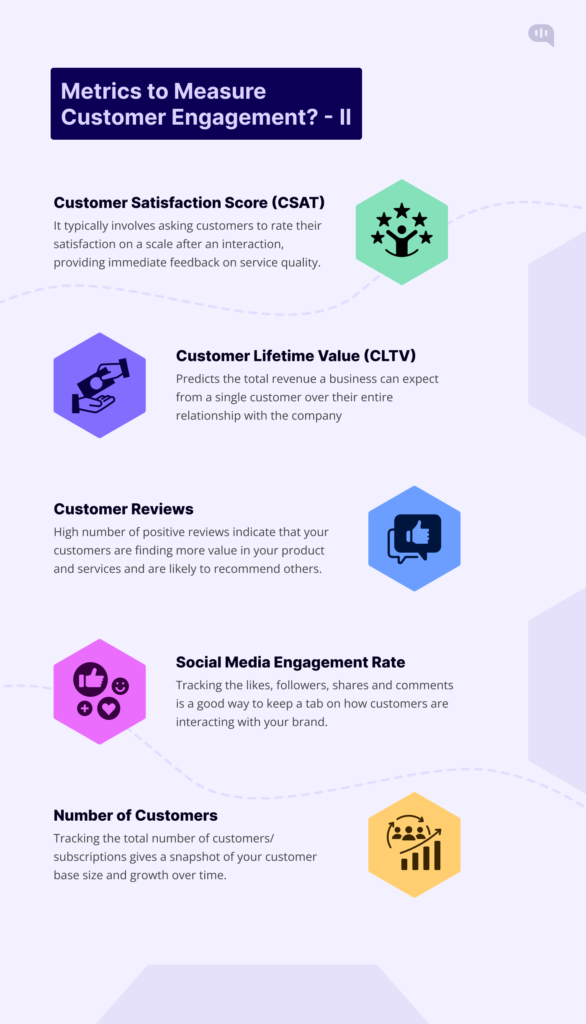
Customer Satisfaction Score (CSAT)
CSAT measures how satisfied customers are with a specific interaction or experience with your product or service. It typically involves asking customers to rate their satisfaction on a scale after an interaction, providing immediate feedback on service quality.
Customer Lifetime Value (CLTV)
Customer Lifetime Value predicts the total revenue a business can expect from a single customer over their entire relationship with the company. It helps in understanding the long-term value of acquiring and retaining customers.
Customer Reviews
Customers today like to voice their opinion about a brand through reviews on different channels such as Google, G2, Capterra, etc. A higher number of positive reviews indicates that your customers are finding more value in your product and services and are likely to recommend others.
Social Media Engagement Rate
Social media plays a key role in marketing for all types of businesses – B2B, B2C, D2C, B2B2C etc. Tracking the likes, followers, shares and comments is a good way to keep a tab on how customers are interacting with your brand and if they are truly happy with our services.
Number of Customers
Tracking the total number of customers/subscriptions gives a snapshot of your customer base size and growth over time, reflecting the success of your engagement tactics.
How to Formulate a Customer Engagement Strategy
Now that we know how to track if our customers are truly engaging with your product, it’s time to see how to use the metrics discussed above to formulate an effective customer engagement strategy.
| Metrics | Challenge | Customer Engagement Strategy |
| Customer Retention Rates | High churn rates and customer attrition | Implement personalized communication and loyalty programs |
| Conversion Rates | Low conversions rates from leads to customers | Optimize website UX, offer personalized incentives, and use retargeting campaigns |
| Average Order Value (AOV) | Low average spend per transaction | Upsell and cross-sell relevant products/services, offer bundle discounts |
| Net Promoter Score (NPS) | Low NPS scores indicating low customer satisfaction | Conduct customer feedback surveys, address pain points promptly |
| Customer Lifetime Value (CLV) | Low CLV due to short customer retention periods | Enhance post-purchase support, nurture ongoing customer relationships |
| Customer Satisfaction Score | Low CSAT scores indicating dissatisfaction | Improve service quality, enhance customer support responsiveness |
| Customer Reviews | Negative or few customer reviews | Encourage satisfied customers to leave reviews, promptly address negative feedback |
| Social Media Engagement Rate | Low engagement metrics on social platforms | Create compelling content, engage actively with followers, run interactive campaigns |
| Number of Customers | Slow customer acquisition growth | Implement referral programs, optimize marketing channels for lead generation |
How to Use Personalization to Increase Customer Engagement?
In today’s world, customers not only desire continuous personalization across all their products. Whether it’s their food orders, movie recommendations, travel itineraries, or more, they anticipate businesses to understand their preferences and adjust their offerings accordingly. When this expectation isn’t met, customers are highly likely to switch to a competitor that does.
On average, 71% of consumers feel frustrated when a shopping experience is impersonal and 63% of consumers stop buying from brands that use poor personalization tactics (Source).
So how to use personalization to your advantage? Let’s see.
Segmentation and Targeting
Divide your customer base into segments based on demographics, behavior, and preferences. Tailor marketing messages, offers, and recommendations to each segment’s specific needs.
Behavioral Tracking and Analysis
Use data analytics to track customer behavior across your platforms. Analyze their browsing history, purchase patterns, and interactions to predict their preferences and anticipate their needs.
Personalized Recommendations
Implement recommendation engines that suggest products or content based on individual preferences and past interactions. This can increase cross-selling and upselling opportunities.
Dynamic Content Personalization
Customize website content, emails, and ads in real-time based on the user’s intent. This creates a more relevant and engaging experience.
Personalized Communication
Use personalized communication channels such as personalized emails, SMS, or in-app messages to deliver relevant updates, offers, and information directly to customers.
Omnichannel Integration
Ensure a seamless experience across all touchpoints (website, mobile app, social media, physical stores). Maintain consistent personalization strategies across channels to provide a unified customer experience.
Transform your customer support with Kommunicate’s
AI-powered email ticketing—resolve queries faster than ever!What is the Role of AI in Customer Engagement?
Starting with the launch of ChatGPT in 2022, AI has undergone a sea change over the past few years. It now impacts several core business areas- customer engagement being one of the most critical.
With its newly found super powers, AI is now able to help businesses level up their customer engagement game. Here are the capabilities that AI uses to effectively manage customer engagement:
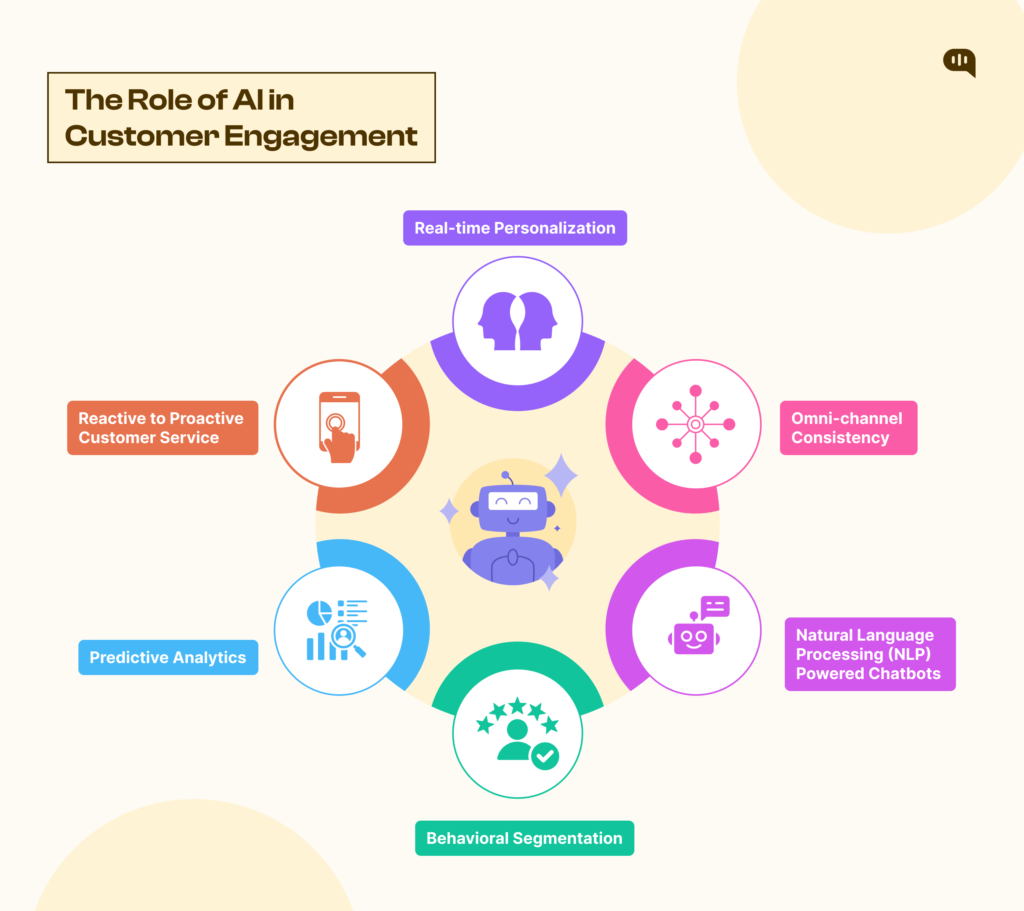
- Real-time Personalization: AI algorithms analyze customer behavior in real-time to customize interactions and offers based on individual preferences and past interactions.
- From Reactive to Proactive Customer Service: AI-powered chatbots are able to pre-empt customer inquiries and issues, providing instant resolutions and improving overall service efficiency. Integration with a customer ticket management system allows these chatbots to seamlessly handle customer queries, ensuring quick and effective resolutions.
- Predictive Analytics: Today, AI has the capabilities to predict future customer behaviors and trends by analyzing historical data, enabling businesses to anticipate needs of the customer and offer proactive solutions.
- Behavioral Segmentation: With AI tools, businesses are able to categorize customers into segments based on their interaction with the product at every other touch point and tailor their marketing strategies and communications accordingly.
- Natural Language Processing (NLP) Powered Chatbots: NLP powered chatbots and virtual assistants have the capability to understand and respond to customer queries in natural language by understanding the context thus enhancing the user experience.
- Omni-channel Consistency: With AI chatbots, it is possible to ensure consistent messaging and service quality across various channels, maintaining a unified customer experience, something which was not possible earlier.
- Serving a Global Audience 24×7: AI-powered chatbots enable businesses to provide round-the-clock customer support and engagement across different time zones and languages, catering to a global audience seamlessly.
Here are some examples of real world companies who have been successful in leveraging AI to drive customer engagement:
- Messe Dusseldorf, one of the biggest organizers of trade fairs in the world uses AI to answer customer queries save ~1000 hours/month.
- Conte.it, a leading auto insurance provider in Italy leverages an AI-based customer engagement strategy to automate 90% of their customer conversations.
- Amiga, a global app that helps parents deal with their children, uses AI to handle 80% of all their customer interactions.

What are Some Tips for Effective Engagement?
Customer Engagement is one of the fastest evolving areas in business, and as we saw in the previous section, AI has added many more dimensions to it. This might get overwhelming at times, so it’s important to keep a few things in mind:
Understand Your Customers
Understand what your customers need and try to gather as much insight as possible using various tools to understand their preferences. Each product and business is different—therefore, do not try to apply a one-size-fits-all approach. Tailor your engagement strategies and use of AI to align closely with your unique customer base and business goals.
Cost vs Benefit Analysis
Before adopting any new AI tools or engagement strategies, conduct a thorough cost vs benefit analysis. Use an ROI calculator to evaluate the potential return on investment (ROI) of implementing is evaluate the potential return on investment (ROI) of implementing AI solutions by comparing the costs (financial, time, and resources) against the expected benefits (improved customer satisfaction, increased sales, operational efficiency).
Consistent Omni-channel Experience
Ensure a seamless experience across all touchpoints—website, mobile app, social media, etc. Identify the key channels where your customers engage with your brand and leverage technologies like AI to maintain consistency in messaging and service quality throughout the customer journey.
Do Not Leave Human Touch
While AI enhances automation and efficiency, remember the importance of human interaction. Balance automated responses with opportunities for personalized and human-driven engagement.
Data Privacy and Transparency
Respect customer privacy concerns and be transparent about how AI is used to personalize experiences. Build trust by clearly communicating data usage policies and offering opt-in/opt-out choices. If not handled carefully, it might do more harm than good!
Continuously Measure & Iterate
Regularly track different metrics like customer satisfaction scores, conversion rates, and retention metrics to see the effectiveness of your engagement strategies and impact of technologies like AI in your strategy. Do not be afraid to drop any tech or strategy that is not helping you achieve your engagement goals.

Empathy and Responsiveness
While technologies like AI can definitely aid in understanding your customers through capabilities like sentiment analysis, predictive analytics etc., genuine empathy and responsiveness are still very important to building strong customer relationships. Hence, stay human and prioritize personal connections in your interactions.
What is the Future of Customer Engagement?
Customer engagement needs to evolve to match growing customer demands and AI is here to help. Here are the trends that will play out in the near future:
Increased AI Adoption
Large enterprises are earmarking a significant portion of their budgets for Gen AI and LLM operations. This will lead to an increase in AI adoption across different verticals, especially in core service processes that involve consumer interactions.
A Human + AI Play
While 2022 was marked with unparalleled enthusiasm for AI, enterprises are now raking up to the challenges involved in its adoption. More enterprises will use a “Human + AI” customer engagement strategy to automate repetitive interactions while letting human employees drive more complex and sensitive conversations.
Better LLMs
OpenAI’s CEO, Mira Murati has indicated that ChatGPT-5 will be far more intelligent than the current models on the market. A model with higher intelligence and EQ will unlock multiple new avenues in customer engagement with AI.
Omnichannel Integrations
Consumers are expecting personalized responses across every channel. Continuity and scalability across different messaging platforms will be one of the key areas of focus for customer engagement. AI platforms that can provide consistent, branded experiences across platforms will become more popular.
To Summarize…
Consumer engagement is moving towards more meaningful and personalized interactions, with over 70% of consumers wanting such interactions from brands and products. Thus, every brand needs to strive to build mutually beneficial relationships with actionable data insights and personalized interactions.
Today, the consumer engagement function is making a move towards quantifying the success of customer engagement using standardized metrics and using AI to personalize and automate client interactions. However, even in the evolving tech landscape, it’s necessary to prioritize returns and relationships with a “AI + Human” communication strategy that prioritizes data privacy and transparency, consistency across channels.
Current trends indicate that as the tech landscape evolves, better LLMs and higher AI adoption rates will drive a better consumer experience across the board.
With 63% of customers saying that they might abandon brands with poor personalization, the best time to start leveraging AI technology for consumer engagement is now.
As the Head of Growth, Marketing & Sales, Yogesh is a dynamic and results-driven leader with over 10+ years of experience in strategic marketing, sales, and business development.



